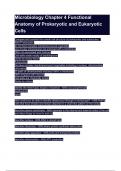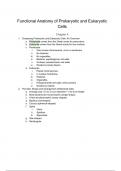Prokaryotic and eukaryo - Study guides, Class notes & Summaries
Looking for the best study guides, study notes and summaries about Prokaryotic and eukaryo? On this page you'll find 56 study documents about Prokaryotic and eukaryo.
Page 2 out of 56 results
Sort by

-
Microbiology Chapter 4 Functional Anatomy of Prokaryotic and Eukaryotic Cells
- Exam (elaborations) • 7 pages • 2024
- Available in package deal
-
- $7.99
- + learn more
Microbiology Chapter 4 Functional Anatomy of Prokaryotic and Eukaryotic Cells
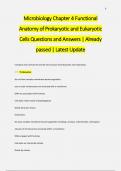
-
Microbiology Chapter 4 Functional Anatomy of Prokaryotic and Eukaryotic Cells Questions and Answers | Already passed | Latest Update
- Exam (elaborations) • 13 pages • 2024
- Available in package deal
-
- $10.99
- + learn more
Compare and contrast the overall cell structure of prokaryotes and eukaryotes. : Prokaryotes: do not have complex membrane-bound organelles one circular chromosome not enclosed with a membrane DNA not associated with histones Cell walls made mostly of peptidoglycan Divide by binary fission Eukaryotes: Do have complex membrane-bound organelles including a nucleus, mitochondria, chloroplast 23 pairs of chromosomes enclosed within a membrane DNA wrapped with histones Cell walls are chemi...

-
BIO 250 Exam 1 Questions and Answers
- Exam (elaborations) • 113 pages • 2024
- Available in package deal
-
- $15.49
- + learn more
Microbiology is the study of: Ans: microorganisms Microscopic, single-cell, cluster, chains carry out life processes independently as ______________ cells. Ans: single Viruses are non-__________________ Ans: cellular True or false: Viruses can be RNA or DNA. Ans: true What are the two themes of microbiology? Ans: basic and applied Applied microbiology is practical problems in _____________________, _______________, and __________________. Ans: agriculture, health, industry Basic ...
Microbiology Chapter 4 Functional Anatomy of Prokaryotic and Eukaryotic Cells.
This document has highlighted important information and reference images to help study. This document goes over chapter 4.
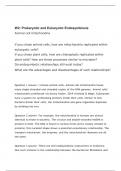
-
BIOL202 Week 2 Discussion; Prokaryotic and Eukaryotic Endosymbiosis
- Other • 2 pages • 2023
-
- $14.49
- + learn more
Week 2: Prokaryotic and Eukaryotic Endosymbiosis Animal cell mitochondria • If you chose animal cells, how are mitochondria replicated within eukaryotic cells? • If you chose plant cells, how are chloroplasts replicated within plant cells? How are these processes similar to microbes? • Do endosymbotic relationships still exist today? • What are the advantages and disadvantages of such relationships?
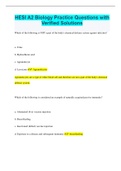
-
HESI A2 Biology Practice Questions with Verified Solutions
- Exam (elaborations) • 49 pages • 2023
-
Available in package deal
-
- $10.99
- + learn more
HESI A2 Biology Practice Questions with Verified Solutions Which of the following is NOT a part of the body's chemical defense system against infection? a. Urine b. Hydrochloric acid c. Agranulocyte d. Lysozyme - Agranulocytes Agranulocytes are a type of white blood cell and therefore are not a part of the body's chemical defense system. Which of the following is considered an example of naturally acquired passive immunity? a. Attenuated (live) vaccine injection b. Breastfeeding c. Ina...
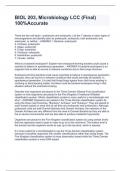
-
BIOL 203, Microbiology LCC (Final) 100%Accurate
- Exam (elaborations) • 47 pages • 2024
-
Available in package deal
-
- $13.99
- + learn more
BIOL 203, Microbiology LCC (Final) 100%Accurate There are two cell types - prokaryotic and eukaryotic. List the 7 classes or basic types of microorganisms and identify each as prokaryotic, eukaryotic, both prokaryotic and eukaryotic, or neither. - ANSWER 1. Bacteria- prokaryotic 2. Archaea- prokaryotic 3. Algae- eukaryotic 4. Fungi- eukaryotic 5. Protozoa- eukaryotic 6. Helminthes- eukaryotic 7. Viruses- neither What is a bacterial endospore? Explain how endospore-forming bacteria c...
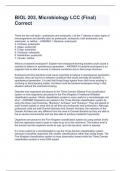
-
BIOL 203, Microbiology LCC (Final) Correct
- Exam (elaborations) • 47 pages • 2024
-
Available in package deal
-
- $13.99
- + learn more
There are two cell types - prokaryotic and eukaryotic. List the 7 classes or basic types of microorganisms and identify each as prokaryotic, eukaryotic, both prokaryotic and eukaryotic, or neither. - ANSWER 1. Bacteria- prokaryotic 2. Archaea- prokaryotic 3. Algae- eukaryotic 4. Fungi- eukaryotic 5. Protozoa- eukaryotic 6. Helminthes- eukaryotic 7. Viruses- neither What is a bacterial endospore? Explain how endospore-forming bacteria could cause a scientist to believe in spontaneous gen...
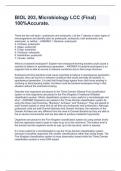
-
BIOL 203, Microbiology LCC (Final) 100%Accurate.
- Exam (elaborations) • 47 pages • 2024
- Available in package deal
-
- $15.49
- + learn more
There are two cell types - prokaryotic and eukaryotic. List the 7 classes or basic types of microorganisms and identify each as prokaryotic, eukaryotic, both prokaryotic and eukaryotic, or neither. - ANSWER 1. Bacteria- prokaryotic 2. Archaea- prokaryotic 3. Algae- eukaryotic 4. Fungi- eukaryotic 5. Protozoa- eukaryotic 6. Helminthes- eukaryotic 7. Viruses- neither What is a bacterial endospore? Explain how endospore-forming bacteria could cause a scientist to believe in spontaneous gen...

How did he do that? By selling his study resources on Stuvia. Try it yourself! Discover all about earning on Stuvia

